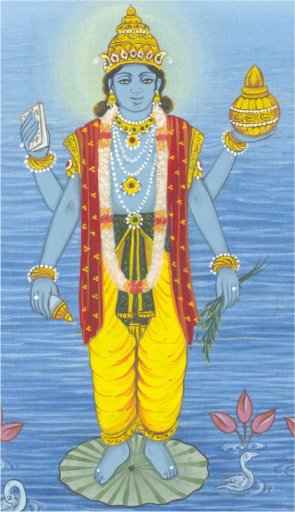
Dhanteras, also known as Dhanatrayodashi, is the first day that marks the festival of Diwali in most of India.

Kārtika is the eighth month of the Hindu calendar, which falls in October and November of the Gregorian calendar. In India's national civil calendar, Kartika is the eighth month of the year, beginning on 23 October and ending on 21 November.
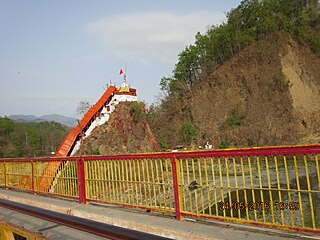
Garjiya Devi Temple is a noted Devi temple located in the Garjiya village near Ramnagar, Uttarakhand, India, on the outskirts of the Corbett National Park. It is a sacred Shakti shrine where Garjiya Devi is the presiding deity. The temple is situated over a large rock in the Kosi River and is one of the most famous temples of the Nainital district, visited by thousands of devotees during Kartik Poornima, a Hindu holy day celebrated on the fifteenth lunar day of Kartik The first priest was Pt. Keshav Dutt Pandey who began worship of Devi Girija. There is also a statue of LakshmiNarayan of 9th century, made from black granite. Many people from nearby areas go there every day to worship in the temple. Many people bathe in the Kosi river near Garjiya temple.
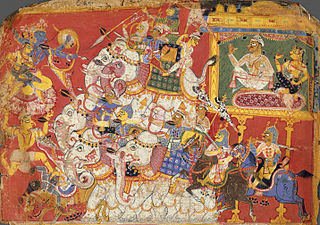
Naraka Chaturdashi is an annual Hindu festival that falls on Chaturdashi of the Krishna Paksha in the Hindu calendar month of Ashwayuja or Kartika. It is the second day of the five-day long festival of Diwali. Hindu literature narrates that the asura (demon) Narakasura was killed on this day by Krishna and Satyabhama. The day is celebrated by early morning religious rituals, and festivities follow on.

Kartika Purnima is a Hindu, Sikh and Jain cultural festival that is celebrated on Purnima. It falls in November or December of the Gregorian calendar and is also known as Tripurari Purnima or Deva-Deepawali, the gods' festival of lights. Karthika Deepam is a related festival that is celebrated in South India and Sri Lanka on a different date. It follows Diwali by about 15 days.

Har Ki Pauri, meaning the feet of Lord Vishnu (Hari), is a ghat on the banks of the river Ganga and landmark of the Hindu holy city of Haridwar in the Indian state of Uttarakhand.

Dashashwamedh Ghat is a main ghat in Varanasi located on the Ganges River in Uttar Pradesh. It is located close to Vishwanath Temple. There are two Hindu legends associated with the ghat: according to one, Brahma created it to welcome Shiva, and in another, Brahma sacrificed ten horses during Dasa-Ashwamedha yajna.

Prabodhini Ekadashi, also known as Deva Uttana Ekadashi, is the 11th lunar day (ekadashi) in the bright fortnight of the Hindu month of Kartika. It marks the end of the four-month period of Chaturmasya, when the god Vishnu is believed to be asleep. It is believed that Vishnu sleeps on the day of Shayani Ekadashi, and wakes on this day.
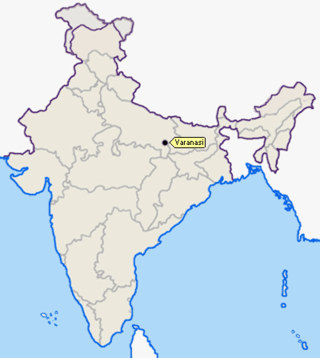
The 2010 Varanasi bombing was a blast that occurred on 7 December 2010, in one of the holiest Hindu cities, Varanasi. The explosion occurred at Sheetla Ghat, adjacent to the main Dashashwamedh Ghat, where the sunset aarti, the evening prayer ritual to the holy river, Ganges had commenced, on these stone steps leading to it, where thousands of worshipers and tourists had gathered. It killed a two-year-old girl, sitting on her mother's lap, the mother was one of three critically injured, more than 38 other people were injured. In the ensuing panic after the blast, a railing broke causing a stampede leading to an increase in the number of injuries. The bomb was hidden inside a milk container on the Sheetla Ghat. The blast occurred a day after the anniversary of the 1992 Babri Masjid demolition, in which a mosque was demolished at Ayodhya leading to nationwide religious riots killing over 2,000 people. Subsequently, the Islamist militant group, Indian Mujahideen, claimed responsibility of the blast, via email to Indian media. This is also the second terrorism-related incident in the city which was rocked by the serial blasts of 2006, in which 28 people were killed, it included an explosion at the Sankatmochan Temple, some two kilometres away.
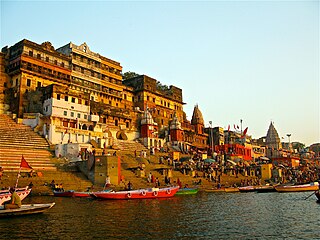
Ghats in Varanasi are riverfront steps leading to the banks of the Ganges river. The city has 84 ghats. Most of the ghats are bathing and puja ceremonial ghats, while two ghats, Manikarnika and Harishchandra, are used exclusively as cremation sites.

Manikarnika Ghat is one of the holiest cremation grounds among the sacred riverfronts (ghats), located on the Ganges, in the city of Varanasi in the Indian state of Uttar Pradesh. In Hinduism, death is considered a gateway to another life marked by the result of one's karma. It is believed that a human's soul attains moksha, and hence breaks the cycle of rebirth when cremated here.

Assi Ghat is the southernmost ghat in Varanasi. To most visitors to Varanasi, it is known for being a place where long-term foreign students, researchers, and tourists live. With hosting Subah-e-Banaras in the morning, assi ghat provides a spectacular notion of river Ganga.
Money Sharma is a photographer, photojournalist and journalist from Mumbai, India and his images have appeared in National Geographic, The Scotsman, Daily News, Mail Online, The Huffington Post, The Washington Post, Hindustan Times and several other national and international publications.

Varanasi is a city on the Ganges river in northern India that has a central place in the traditions of pilgrimage, death, and mourning in the Hindu world. The city has a syncretic tradition of Muslim artisanship that underpins its religious tourism. Located in the middle-Ganges valley in the southeastern part of the state of Uttar Pradesh, Varanasi lies on the left bank of the river. It is 692 kilometres (430 mi) to the southeast of India's capital New Delhi and 320 kilometres (200 mi) to the east of the state capital, Lucknow. It lies 121 kilometres (75 mi) downstream of Prayagraj, where the confluence with the Yamuna river and mythical Saraswati river is another major Hindu pilgrimage site.

Vaikuntha Chaturdashi is a Hindu holy day, which is observed on chaturdashi, the 14th lunar day of the waxing moon fortnight of the Hindu month of Kartika (November–December). The day is sacred to the deities Vishnu and Shiva. They are worshipped individually or together in different temples in Varanasi, Rishikesh, Gaya, and Maharashtra.
Varanasi, also known as Kashi, is considered as the religious capital of Hinduism. In the Hindu faith, it is the holiest of all of its cities; the four dhams in the four cardinal directions of the country – Badrinath in the north, Puri in the east, Dwarka in the west and Rameshwaram in the south – are all represented in the city in "archetypal forms" as the presiding deities at Badrinath Ghat, Assi's Jagannath Temple area, Shankudhara Pokhra, and Mir Ghat respectively. Other Hindu holy places, such as the Kedarnath at Kedar Ghat, Mathura at Bakaruia Kund or Nakhi Ghat, Prayagraj (Allahadbad) at Dashahvamedha Ghat, Kamakhya (Assam) at Kamachha, Kurukshetra at Kurkukshetra Kund near Asi, and Lake Manasarovar at Mansarovar near Shyameshvara are a part of the city's religious and cultural heritage.

Sant Ravidas Ghat is the southernmost and largest ghat in Varanasi. To most visitors to Varanasi, it is known for being an important religious place for Ravidasis with a 25 acres park known as Sant Ravidas Smarak Park.

Gandhi Ghat is one of the main ghats on the Ganges River in Patna. It is named after the leader of the Indian independence movement Mahatma Gandhi. The ghat is famous for its Evening Ganga Aarti. It is also associated with the immersion of ashes of Mahatma Gandhi in the river Ganges.

Ganga Dussehra, also known as Gangavataran, is a Hindu festival celebrating the avatarana (descent) of the Ganges. It is believed by Hindus that the holy river Ganges descended from heaven to earth on this day. Ganga Dussehra takes place on Dashami of the waxing moon of the Hindu calendar month Jyeshtha. The festival celebration lasts ten days, including the nine days preceding this holy day.
Sua is a folk song sung by Gond women from the state of Chhattisgarh during the festival of Deepawali. The name 'Sua' comes from the word for 'parrot', a bird known for repeating phrases. According to folklore, women sing songs conveying messages through parrots, expressing their hearts' feelings with the belief that the parrot will convey the agony of their heart to their lover. It is sometimes called the 'Viyog', or 'separation' song. This folk song is usually sung during the paddy harvest. After Deepawali, Gondi women continue singing the song for two months.




















